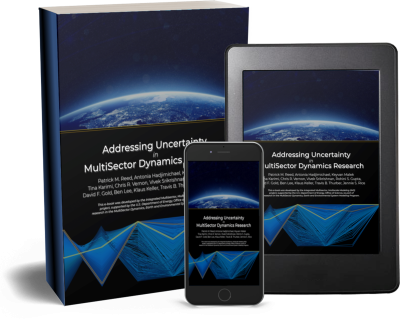Addressing Uncertainty in Multisector Dynamics Research
This online book provides an open science “living” resource on uncertainty characterization methods for the MultiSector Dynamics (MSD) community and other technical communities confronting sustainability, climate, and energy transition challenges. The last decade has seen rapid growth in science efforts seeking to address the interconnected nature of these challenges across scales, sectors, and systems. Understanding and managing uncertainty is crucial for making consequential model-based insights. The book explains various methods of uncertainty characterization, including global sensitivity analysis and exploratory modeling. By addressing uncertainty, researchers can advance our ability to provide insights into human-natural system interactions and help make better-informed decisions.
This online book is the first comprehensive resource for confronting the computational and conceptual challenges of MSD science. The book provides a technical primer on key elements of uncertainty characterization, including ensemble-based design of experiments and global sensitivity analysis. Other resources include a glossary to help bridge terminology challenges, a summary of uncertainty quantification tools for more advanced readers, and a suite of Jupyter notebook tutorials that provide hands-on training. This text itself represents a strong commitment to open science and will evolve as a living resource as researchers provide feedback, innovations, and future tools.
The guidance provided in this online book can be used to frame consistent and rigorous experimental designs for better understanding the consequences and insights from modeling choices. The progression of sections in this text provides a thorough introduction to the concepts and definitions of diagnostic model evaluation, sensitivity analysis, and uncertainty characterization (UC). In addition, it comprehensively discusses how specific modeling objectives and applications should guide the selection of appropriate techniques; broadly, these can include model diagnostics, in-depth analysis of the behavior of the abstracted system, and projections under conditions of deep uncertainty. This text also contains a detailed presentation of the main sensitivity analysis methods and a discussion of their features and limitations. Readers are provided with an overview of computer tools and platforms that have been developed and could be considered in performing UC. The appendices include an overview of uncertainty quantification methods, a terminology glossary of the key concepts, as well as Jupyter notebooks providing hands-on training with example test cases and scripts to showcase various UC-related capabilities.

